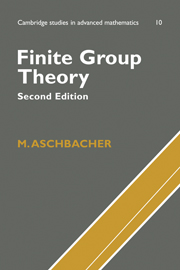Book contents
- Frontmatter
- Contents
- Preface
- 1 Preliminary results
- 2 Permutation representations
- 3 Representations of groups on groups
- 4 Linear representations
- 5 Permutation groups
- 6 Extensions of groups and modules
- 7 Spaces with forms
- 8 p-groups
- 9 Change of field of a linear representation
- 10 Presentations of groups
- 11 The generalized Fitting subgroup
- 12 Linear representations of finite groups
- 13 Transfer and fusion
- 14 The geometry of groups of Lie type
- 15 Signalizer functors
- 16 Finite simple groups
- Appendix
- References
- List of Symbols
- Index
11 - The generalized Fitting subgroup
Published online by Cambridge University Press: 05 June 2012
- Frontmatter
- Contents
- Preface
- 1 Preliminary results
- 2 Permutation representations
- 3 Representations of groups on groups
- 4 Linear representations
- 5 Permutation groups
- 6 Extensions of groups and modules
- 7 Spaces with forms
- 8 p-groups
- 9 Change of field of a linear representation
- 10 Presentations of groups
- 11 The generalized Fitting subgroup
- 12 Linear representations of finite groups
- 13 Transfer and fusion
- 14 The geometry of groups of Lie type
- 15 Signalizer functors
- 16 Finite simple groups
- Appendix
- References
- List of Symbols
- Index
Summary
We've seen that the composition factors of a finite group control the structure of the group in part, but that control is far from complete. Section 31 introduces a tool for studying finite groups via composition factors ‘near the bottom’ of the group. The generalized Fitting subgroup F*(G) of a finite group G is a characteristic subgroup of G generated by the small normal subgroups of G and with the property that CG(F*(G)) ≤ F*(G). This last property supplies a representation of G as a subgroup of Aut(F*(G)) with kernel Z(F*(G)). G can be effectively investigated via this representation because F*(G) is a relatively uncomplicated group whose embedding in G is particularly well behaved.
It turns out that F*(G) is a central product of the groups Op(G), p ε π(G), with a subgroup E(G) of G. To define E(G) requires some terminology. A central extension of a group X is a group Y together with a surjective homomorphism of Y onto X whose kernel is in the center of Y. The group Y will also be said to be a central extension of X. A group L is quasisimple if L is perfect and the central extension of a simple group. The components of G are its subnormal quasisimple subgroups, and E(G) is the subgroup of G generated by the components of G. It develops that E(G) is a central product of the components of G.
- Type
- Chapter
- Information
- Finite Group Theory , pp. 156 - 176Publisher: Cambridge University PressPrint publication year: 2000



